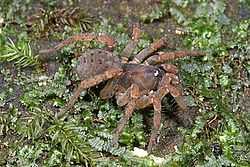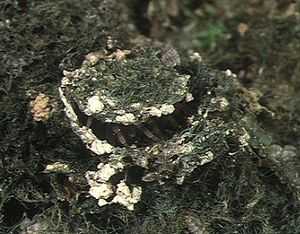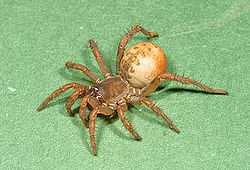Liphistiidae
| Liphistiidae | |
|---|---|
 | |
| female Ryuthela tanikawai | |
| Scientific classification | |
| Kingdom: | Animalia |
| Phylum: | Arthropoda |
| Class: | Arachnida |
| Order: | Araneae |
| Suborder: | Mesothelae |
| Family: | Liphistiidae Thorell, 1869 |
| Genera | |
| Diversity | |
| 5 genera, 85 species | |
 | |
The spider family Liphistiidae comprises 3 genera and 89 species from Southeast Asia, China, and Japan. They are among the most basal living spiders, belonging to the suborder Mesothelae. In Japan, the Kimura-gumo (Heptathela kimurai) is rather well-known.
Biology

Liphistiidae are rarely seen, tube-dwelling spiders that construct rudimentary trap-doors, characterized by their downward pointing, daggerlike chelicerae,[1] and by having a segmented series of plates on the upper surface of their abdomens. Some make silk trip-lines radiating away from the burrow entrance. They are active at night and live for many years, and females molt after maturity. Adult males wander in search for females, which rarely leave their burrows. The respiratory system consists only of book lungs, which could be a reason why these spiders show a quite low level of activity.[2] In the past they were frequently believed to lack venom entirely, but in 2010 it was shown that at least Liphistius do have venom glands.[3]
Although most species live in burrows, cave-dwelling species also fasten their retreats to the cave walls. Both burrows and retreats are sealed with woven doors.[4]
Malaysian species
In caves in Malaysia, three different species of Liphistius are known, and each species is endemic to just one or two caves.[5] The most well known of them is Liphistius batuensis, which is found in Batu Caves. Other species that can be found in Malaysia include Liphistius malayanus, Liphistius murphyorum and Liphistius desultor which can be found in cool-humid places.
The Malaysian trapdoor spiders are protected by local law. Continuous threats come from loss of habitat and collection by exotic pet traders. It is believed that most of the species are endemic henceforth once an isolated habitat is destroyed, the species might go into extinction.
Systematics
Although they are Orthognatha (having downward pointing chelicerae), like the Mygalomorphae, there is no close relationship between those two. It is thought that the common ancestor of all spiders was orthognath, and that in the Opisthothelae, comprising Mygalomorphae (mostly tarantulas) and Araneomorphae (all other spiders), only the Araneomorphae changed their alignment of chelicerae, while the mygalomorphs retained this symplesiomorphic feature.[2]
Genera
- Heptathela Kishida, 1923 — Vietnam, Japan, China (34 species)
- Liphistius Schiødte, 1849 — Southeast Asia (49 species)
- Ryuthela Haupt, 1983 — Ryukyu Islands, Okinawa (7 species)
See also
- List of Liphistiidae species
- Spider families
Footnotes
References
- Coddington, J.A. & Levi, H.W. (1991): Systematics and Evolution of Spiders (Araneae). Annu. Rev. Ecol. Syst. 22: 565-592. doi:10.1146/annurev.es.22.110191.003025
- Ono, H. (1999) Spiders of the genus Heptathela (Araneae, Liphistiidae) from Vietnam, with notes on their natural history. The Journal of Arachnology 27(1): 37-43. PDF
- Murphy, Frances & Murphy, John (2000): An Introduction to the Spiders of South East Asia. Malaysian Nature Society, Kuala Lumpur.
- Haupt, J. (2004): The Mesothelae - a monograph of an exceptional group of spiders (Araneae: Mesothelae). Zoologica 154: 8. ISSN 0044-5088, ISBN 3-510-55041-2 — Abstract
- Platnick, Norman I. (2011): The world spider catalog, version 12.0. American Museum of Natural History.
External links
| Wikispecies has information related to: Liphistiidae |
| Wikimedia Commons has media related to Mesothelae. |
| |||||||||||||||||||
